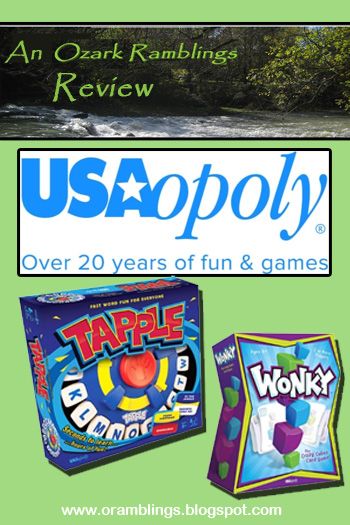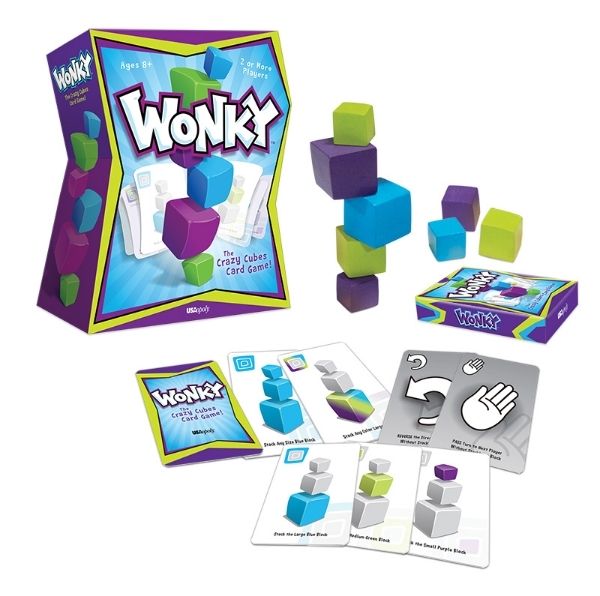 Every time the UPS man drops off a review product I feel like it’s Christmas morning. That’s not always the case for my son, but this time he agreed with me because our box from USAopoly contained two games. Tapple: Fast Word Fun for Everyone is a battery-operated game for 2-8 players. I’m not sure what gets more of a workout—my memory or my creative thinking. Wonky: The Crazy Cubes Card Game, for 2 or more players. proves you can’t take something as simple as stacking blocks for granted.
Every time the UPS man drops off a review product I feel like it’s Christmas morning. That’s not always the case for my son, but this time he agreed with me because our box from USAopoly contained two games. Tapple: Fast Word Fun for Everyone is a battery-operated game for 2-8 players. I’m not sure what gets more of a workout—my memory or my creative thinking. Wonky: The Crazy Cubes Card Game, for 2 or more players. proves you can’t take something as simple as stacking blocks for granted.
This review couldn’t have come at a better time…in an effort to help my Schnickelfritz fall asleep in a timely manner, we have turned off the television/computer/Kindle an hour before his bedtime. To fill the void we’ve been playing games together and these two have quickly become favorites. They also work well with larger groups, like when we get together with another homeschooling family and there are seven of us sitting around the table.
The Tapple device has 20 tabs labeled with the most commonly used letters of the alphabet (no q,u,v,x,y,or z). In each round players think of of words that begin with each letter and fit into the category listed on a randomly selected card. I counted 36 cards with my game, each containing four color-coded categories- the white and blue ones are deemed easier and may be suited for younger players, the

yellow and red ones are tougher. The cards store on the underside of the Tapple wheel. Two AA batteries run the timer—each player is allowed ten seconds to give an answer, tap the appropriate starting letter, and tap the red center to reset the timer for the next player. If you can’t come up with a word using one of the remaining letters in your time limit you are knocked out for that round. If you sweep the board and are still playing the yellow knob resets the letters and you go again—this time naming two words.
Scnickelfritz has issues with timers and since we were playing near bedtime when the goal is to calm down, not raise anxieties, we often played without it. Our best category was fictional characters. We managed to make it through 4 rounds jumping from movies to books. We hit all the dwarves from The Hobbit, Marvel superheroes, etc. I was particularly pleased when Fritz came up with Ichabod Crane and Ishmael (as in “Call me…” from Moby Dick) for his I words. This might make it sound like a game for intellectuals, but there are plenty of pop culture categories too like Sports team mascots.
Now first and foremost this is a game, a really fun game, that can be enjoyed by anyone—but since this is mostly a homeschooling blog I want to share how this can also be used as a review/drill tool. Some of the categories naturally lend themselves to school subject. I found: nouns, verbs, adjectives, bugs & insects, U.S. Cities, birds, body parts, etc. That’s grammar, science, and geography right there. You could also tweak it and decide the nouns and verbs had to be in the foreign language you are studying or make your own category.
 I’ll be honest and say I wasn’t sure how my son would take to Wonky. He’s been playing and building with blocks his whole life—(it’s his self-comfort thing), but these blocks are built with curved edges and less than perfect right angles. Would my perfectionist son be able to appreciate these slightly askew blocks? Turns out he could.
I’ll be honest and say I wasn’t sure how my son would take to Wonky. He’s been playing and building with blocks his whole life—(it’s his self-comfort thing), but these blocks are built with curved edges and less than perfect right angles. Would my perfectionist son be able to appreciate these slightly askew blocks? Turns out he could.
Each player starts with a number of cards that direct which block to place on the stack next based on the block’s attributes: size and color. For every block successfully stacked they get to discard the card. If the stack topples they must pick up three cards. First one out of cards wins (this takes several rounds since there are only nine blocks).
It seems like a game of dexterity and being able to sense center of gravity, but there can be a deal of logical thinking going on in a player’s head. If you don’t have a playable card, you must draw until you get one. I saw my son begin to intuit the value of

the cards—that it’s better to play the specific ones (e.g. stack the medium blue block) first when the chances of those blocks being available is highest and save the “wild cards” (e.g. stack any blue block, or better any size/any color) for later in the game. I even noticed the boys judging when it was best to try and sabotage the stack for the next player in hopes of it toppling (so that someone down to 1 card would be forced to pick up more).
The Wonky game comes with a bag to hold the blocks and cards and fits easily in my purse. I was able to take it to co-op and had several people play while they waited for friends and siblings to finish up tests. All you need is a smooth flat surface. If a table wasn’t available we’d use a book. The picture to the right was the first time my son succeeded in using all nine blocks in a stack. I was so nervous that my getting up and crossing the floor to get the camera would send his hard work tumbling down.
Again, this is a game first but it could be a learning opportunity for very young ones who need to learn the small, medium, large, concept. Because the cards show which block to play in addition to the text, it could be played by non-readers.
If you’re looking for some Christmas gift ideas, I can recommend these two USAopoly games.



No comments:
Post a Comment